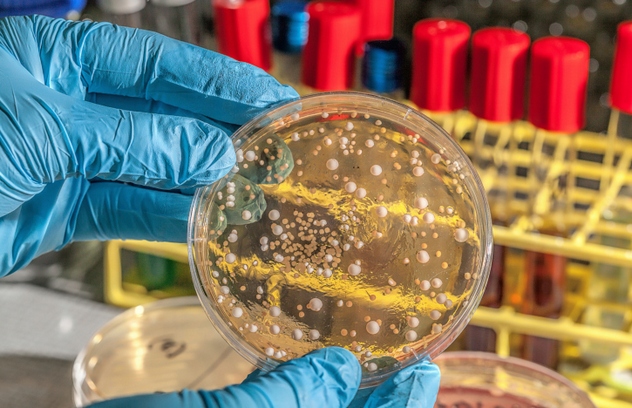 Our World
Our World  Our World
Our World  Pop Culture
Pop Culture 10 Incredible Female Comic Book Artists
 Crime
Crime 10 Terrifying Serial Killers from Centuries Ago
 Technology
Technology 10 Hilariously Over-Engineered Solutions to Simple Problems
 Miscellaneous
Miscellaneous 10 Ironic News Stories Straight out of an Alanis Morissette Song
 Politics
Politics 10 Lesser-Known Far-Right Groups of the 21st Century
 History
History Ten Revealing Facts about Daily Domestic Life in the Old West
 Weird Stuff
Weird Stuff 10 Everyday Products Surprisingly Made by Inmates
 Movies and TV
Movies and TV 10 Actors Dragged out of Retirement for One Key Role
 Creepy
Creepy 10 Lesser-Known Shapeshifter Legends from Around the World
 Our World
Our World 10 Science Facts That Will Change How You Look at the World
 Pop Culture
Pop Culture 10 Incredible Female Comic Book Artists
 Crime
Crime 10 Terrifying Serial Killers from Centuries Ago
Who's Behind Listverse?

Jamie Frater
Head Editor
Jamie founded Listverse due to an insatiable desire to share fascinating, obscure, and bizarre facts. He has been a guest speaker on numerous national radio and television stations and is a five time published author.
More About Us Technology
Technology 10 Hilariously Over-Engineered Solutions to Simple Problems
 Miscellaneous
Miscellaneous 10 Ironic News Stories Straight out of an Alanis Morissette Song
 Politics
Politics 10 Lesser-Known Far-Right Groups of the 21st Century
 History
History Ten Revealing Facts about Daily Domestic Life in the Old West
 Weird Stuff
Weird Stuff 10 Everyday Products Surprisingly Made by Inmates
 Movies and TV
Movies and TV 10 Actors Dragged out of Retirement for One Key Role
 Creepy
Creepy 10 Lesser-Known Shapeshifter Legends from Around the World
10 Things You Should Know About Biohacking
“Biohacking” is a term that’s floating around with increasing regularity. It’s defined as a sort of citizen biology; most of the work is done in small, independent labs by people in their spare time, mucking about with things like modifying plant DNA to impact growth or isolating certain genetic material to enhance or improve on it. And that’s the basic idea of the movement—improving on biological entities, sort of like upgrading your computer.
Biohacking venues are popping up around the world, giving people all the tools they need to start exploring their world in a very biological—and sometimes terrifying—way. Critics point out that the word “hack” was always a threatening, illegal thing. Even though it’s mostly an expression of curiosity, some really weird things have come out of the movement. That’s especially true now that we’re developing ways to biohack not just plants but people.
10The Big Brother-esque Beginning
The true scope of the potential of biohacking really got its start at the University of Reading, with a professor named Kevin Warwick. Warwick and his colleagues in the Cybernetics Division wanted to know if they could build a computer that would interface with the biological systems of a person.
They could.
Dubbed “Project Cyborg,” Warwick implanted the first chip in his arm in 1998. The chip sent out a signal that allowed a computer to track Warwick, opening doors for him and turning on lights and computers as he moved through the department. That experiment was soon followed by another, in which Warwick implanted one chip in his wife and a similar one in himself. The matching chips allowed him to feel what she was doing, and Warwick claimed it was a sort of electronic telepathy.
Not surprisingly, Warwick is a pretty controversial character in the scientific community. More recent experiments have brought him steps closer to combining the electronic and the technical with the biological. In 2011, he progressed to using robots to transmit information through sensors into brain cells grown in culture, in order to get those cells to process information and begin to interact with outside stimuli.
According to Warwick, it’s difficult work, because the cells don’t always seem to do what he wants and are developing a moody mind of their own. Right now, Warwick is just using rat cells, but he’s hoping that within a few years he’ll have progressed to human brain cells, being able to create a human brain in a dish that can interact with everything in the lab. Warwick, who also claimed to have created the computer that beat the Turing test (a feat which is still up for debate), is undoubtedly breaking down some serious boundaries between the biological and the technological.
9Genetically Modifying Bacteria Into Building Material

Biohacking can involve modifying cells on a genetic level, and what cells can be made to do is pretty wild. JuicyPrint is an up-and-coming project that hacks bacteria to respond to light. The bacteria produce cellulose, and with some alterations to its genetic code, that cellulose production can be tuned to respond to the presence—or absence—of light. Shine light on it, and it produces cellulose. Take the light away, and that production stops.
As the name suggests, JuicyPrint then uses the natural substance as the raw material in a 3-D printer. Expose the layers of bacteria to light, and cellulose will be produced in whatever shape you want. The potential uses for the technology are nearly limitless. With the creation of a biologically compatible, very strong substance that can be reproduced and printed just from light, there’s a whole new option for medical technology. Those behind the project see it being used for everything from rebuilding organs to making new arteries and blood vessels. Because the new organs and implants would be based on a biological material instead of an artificial one, it’s expected to blend more seamlessly into a human body, with less risk of things like blood clots.
The goal for the final project is to feed fruit juice to the printer to spit out whatever shapes are needed. The genetically engineered strain of bacteria is one that’s commonly found in things like vinegar, juice, and the leftover waste from beer brewing. This not only leaves a huge supply of raw materials, but with the success that’s already been had in using bacterial cellulose to prepare skin grafts, the possibilities are nearly endless.
8Magnetic Touch

Biohacking doesn’t have to alter DNA or genetic material. It can also combine technology with the biological along the lines of Kevin Warwick’s vision. The people that do it are called “grinders.” One of the first examples of this was the insertion of magnets into a person’s fingertips. Not surprisingly, it’s a rather underground movement, and it’s usually done in places like body modification shops and piercing parlors. The movement is catching on. Take Pittsburgh’s underground Grindhouse Wetwares, run by an electrical engineer and a software developer. The name comes from the idea that there are three different elements in what they’re doing—the computers and the machinery are the hardware, the programs are the software, and the humans? They’re the wetware.
Implanting magnets in someone’s fingertips isn’t just about using them to pick things up. According to those that have it done, the human body gradually adapts to having the magnet in place and starts to read the signals it receives as though it’s just another biological part of the body. They liken it to wearing glasses and your body adjusting to them while your senses are heightened. Just what kind of impact modifications like these will have on those that get them remains to be seen. While some claim to be able to use the magnets implanted in their bodies like an extra sense, others claim that the feeling fades within a few weeks, and you’re just left with the neat party trick of being able to use the Force on a very small scale.
7Echolocation
Implanting machines into the human body to access another sense or heighten the ones we’re already aware of isn’t just in the realm of party tricks—some are already looking at biohacking as a way to improve their quality of life.
Rich Lee is 34 years old, and he knows that he’s going blind. He lost most of the sight in his right eye overnight, and he’s looking toward a time, very soon, where he’s going to be legally blind. While he still has his sight, though, he’s training himself to use echolocation.
It’s done with sound-transmitting magnets, which Lee has implanted in his ears. While they’re usually used for things like listening to music so no one else can hear it (or is even aware that you’re doing it), Lee is also training himself to interpret the sounds that he hears. The magnets were implanted by a body modification artist in Las Vegas and act as receivers for sound. Listening to music, for example, means that Lee carries a battery pack and an amplifier that relays sound through a coil. The coil transfers the sound to the magnets, and the magnets vibrate, allowing Lee to hear the music.
Echolocation is a bit more complicated, though, and it’s taking more experimentation with everything involved, from the amplifiers to the battery packs. Eventually, Lee is hoping to add an ultrasonic rangefinder to be able to “see” through his implants.
6Humanity+ And Transhumanism

Humanity+ is an international, nonprofit organization dedicated to mainstreaming what many basement biohackers are trying to do—improve humanity with the help of technology. The organization operates under the mission statement of using technology for ethical reasons, as well as focusing on the expansion of human capabilities to create the next step in human evolution. That includes extending the human life span and cracking through barriers when it comes to things like smart prosthetics, cryonics, and regenerative medicine.
They’re also adopting the philosophical school of transhumanism. At its core, transhumanism is the idea that the human race as we know it now is little more than a sort of early prototype. With help from technology, implants, and genetic engineering, we’re going to evolve to something beyond human, which transhumanists also call “posthuman.” Along with the actual physical process of undergoing these changes, they’re also interested in some of the ethical questions and moral responsibilities that come with advancement, such as what we’re going to end up doing with these technological superpowers.
Humanity+ states that this is absolutely not a new idea, even though it’s only in the past few decades that we’ve really been able to explore transhumanism on a large scale. They argue that the history of the movement goes way back and that its roots can be seen in the Greek idea of using ambrosia on the skin to prevent aging and decay and the alchemical attempts to create an elixir of life.
5The Goal: A Posthuman
In the case of biohacking, a posthuman is as close to an end goal as you can really get in an ever-changing field. Transhumanism—and the idea of creating the transhuman—is only the middle step. The end goal is the posthuman. The posthuman is defined as a creature that’s no longer human by today’s standards. It would be a sort of humanity that is as far from what we are today as our primate cousins are from us. We recognize their thoughts, their feelings, and their family structure, but we still retain our feelings of superiority with the knowledge that most of us no longer have the urge to throw our poop. Posthumans will see us, as we are today, as the poop-flingers.
Proponents of the movement suggest we’ll be capable of complete control over emotions and mental states, an increased capacity for things like love and pleasure, and longer, healthier lives. There may be states of consciousness that we’re not aware of now that the posthuman will experience daily. And to access all of this, the posthuman will need to be a completely redesigned human, incorporating genetic engineering, the introduction of nanotechnology, neural interfaces, and implantable, wearable computers. This process will fundamentally alter our idea of the self.
What’s not known—at all—is just what this is all going to look like. Humanity+ suggests that it might be some sort of synthetically created artificial intelligence or that we might get rid of our bodies completely and live inside information networks like the Internet. “Transhuman” only refers to the “transitional human” that’s created as a stepping stone.
4The Political Party
In case it might seem like the transhumanist movement is something out of the movies or is all about people trying to become their favorite character from the X-Men, supporters of biohacking and of the movement are making sure everyone know they’re serious: They’ve formed a political party, and they’re running for US president.
The platform of the party is working toward a government that makes science, technology, and health a priority. Their goals are incredibly lofty, especially given that biohacking is really still in its infancy. They’re already taking the true politician’s standpoint of promising the incredible. They’re hoping to bring the grinders out of basements and body modification shops and encourage technological and scientific advancement to the point where aging and death are obsolete—all within 15–20 years. They’re also for creating guidelines for ethical use of new technologies, as well as getting away from the death culture and a society that spends billions on medicine that, in the end, might only prolong life a little bit. Zoltan Istvan, the founder of the Transhumanist Party, says they won’t just be promoting science, they’ll be using it. They’re even going as far as to support ideas like mind-reading headsets and suspended animation.
They’re pretty realistic about their slim chances of getting anywhere in the 2016 election, but Istvan, who’s also the presidential candidate, is happy that it’s a start. And if it seems unlikely or far-fetched that a candidate running for office on a platform of telepathic devices and everlasting, technologically enhanced life would get anywhere, they already have in Italy. Italy’s first Transhumanist Party candidate was elected to parliament in 2012. Transhumanist MP Giuseppe Vatinno was taken with the idea of Humanity+ and what he described as an action-oriented view of the world’s problems. At the top of his list of important advancements is nanotechnology, followed very closely by biotechnology and artificial intelligence.
3Regulating Nootropics

Biohacking bodies doesn’t always have to mean getting out a scalpel and starting to cut. The “nootropics” movement is one that’s growing quickly, and it’s based around the idea of taking brain-enhancing drugs to make you focus better, think faster, and work more efficiently. Not surprisingly, one of the hubs of nootropics experimentation is in Silicon Valley, and thanks to Reddit, the field of nootropics has turned into a pretty cool crowdsourcing experiment.
The worldwide phenomenon is a big one, especially considering there’s no real, solid definition for what’s going on. There’s “stacking,” which is combining pills and substances for a certain effect. Some people are taking it to extremes, popping pill cocktails of up to 40 different pills a day. The most commonly recommended substances for people to start on? Caffeine and L-theanine found in coffee and tea. Those are on the rather tame end of the scale. At the other end are the habitual users of things like Ritalin, Adderall, and modafinil. More mainstream nootropics advocates say that these are technically not nootropics, but the basics are the same—altering brain chemistry to make you more productive.
So what’s the long-term impact of taking these drugs and drug cocktails? No one’s sure, in spite of the fact that it’s certainly not a new idea. Nootropics got their start in 1964, with a chemical cocktail called “piracetam.” Created by a Romanian chemist and psychologist named Corneliu Giurgea, the drug and his guidelines set the stage for today’s nootropics. According to Giurgea, the drugs must be able to enhance learning, improve processing, and increase the activity between the brain’s two hemispheres, along with being nonaddictive and nontoxic.
But right now, there’s no real way of determining what the long-term impact of these brain-altering drugs will be. And there are legal issues with them, too. We mentioned modafinil, which has been used to treat narcolepsy and has been tested, proven safe, and used by Air Force pilots to stay awake during long-range missions. It’s also illegal to sell in the UK without a prescription, but selling nootropics that haven’t been tested is legal. Those who are erring on the side of caution point to early experiments in biohacking brain activity like Project MKULtra, and we all know how that turned out.
2Steve Kurtz And The Biological Countermeasures Unit

If you think there’s a high probability for something to go wrong when people start tinkering with DNA, the FBI agrees with you.
In 2006, the FBI established the WMD Directorate, and a part of that is the Biological Countermeasures Unit. Its official job is to prevent acts of bioterrorism, and with biohacking, that’s become increasingly more difficult to oversee. That’s not necessarily because of the biohackers themselves, but because it’s increasingly easy to get access to lab equipment and biological agents. In each of their 56 field offices across the country, there’s at least one person trained in biosecurity. They’re also making it a point to reach out to scientists of all levels not just so they know what’s going on, but so that they can help ensure DIY researchers are doing things safely. In 2013, a group of biohackers were invited to a meeting with the FBI in California, where they were quizzed on just what they were doing and why. The outreach program is a part of the learning curve that’s required to find the balance between encouraging citizen science and making sure the next deadly flu isn’t accidentally released. Unfortunately, one of the most famous cases of suspected bioterrorism is an incredibly sad, tragic story.
Steve Kurtz is a professor of art at SUNY Buffalo. In 2004, he and his wife, Hope, were preparing an art exhibit for the Massachusetts Museum of Contemporary Art. Hope Kurtz suddenly passed away due to heart failure, and when her husband called 911, first responders saw the petri dishes that were being prepared for the exhibit. Even though they were harmless, Kurtz was arrested and held in custody, his wife’s body seized from the coroner for further analysis. Bioterrorism groups descended on his home and office, including representatives from the Department of Defense, the Joint Terrorism Task Force, and Homeland Security. His home was condemned as a health risk, and it wasn’t until a week later that the Commissioner of Public Health for New York State finished testing the samples and came to the conclusion that there was nothing hazardous about them. It was only then, too, that Kurtz could reclaim his wife’s body. Even Kurtz’s cat was confiscated as a possible carrier of disease, though he found the cat back in his home after he was released.
1So What Are The Potential Dangers?

While many biohackers say that organizations like the FBI are overreacting to the potential dangers, others are trying to show just how under-the-skin implants can be used for evil instead of good. US Navy petty officer Seth Wahle picked up a chip that was originally supposed to be used for monitoring cattle. He injected it into his hand, and it’s now undetectable—by humans, at least.
Wahle has demonstrated how the chip can be equipped with a Near Field Communications (NFC) antenna that sends a signal out to any nearby Android phone. It prompts the user to open a file, and once they click on the link, they’re giving full control of their phone to a remote computer. The whole thing is still in its infancy, but the principle is sound. The amount of programming needed to make the link appear legitimate is certainly not extensive. Currently, the remote computer is disconnected when the phone is turned off, but that’s also an easy enough problem to solve by downloading a program on the hijacked phone that starts when it’s turned on.
Perhaps the most terrifying thing is how undetectable it is. Wahle was in the military when he had the chip implanted, and they never knew it was there. He says that he went through military scanners on a daily basis, along with going through airport security and checkpoints. No one ever discovered he was implanted with a device that could give him control of any Android phone.
Done with the help of a security consulting firm, the implants and the programming show just how easy it is to not just implant a device that’s activated simply by coming in contact with its target but that’s completely undetectable by all our military and airport security systems. Wahle and his colleagues suggest that this is just the beginning of the biohacking threat and point out that it can be done with materials anyone can get their hands on.








